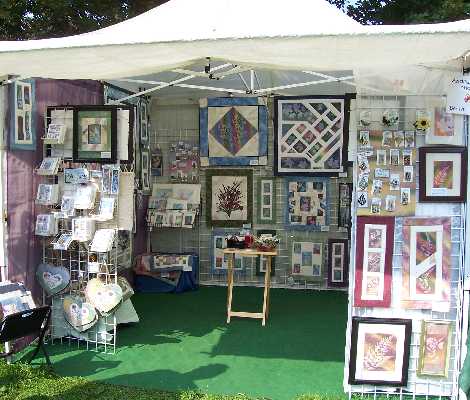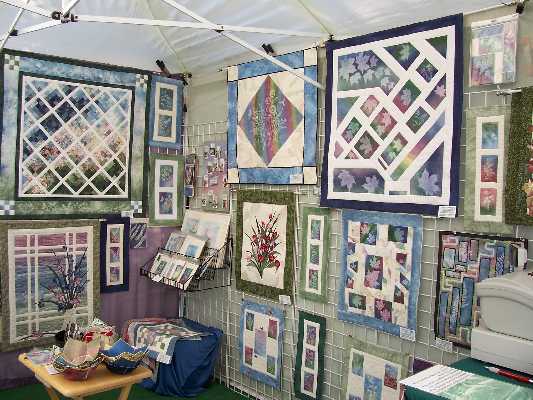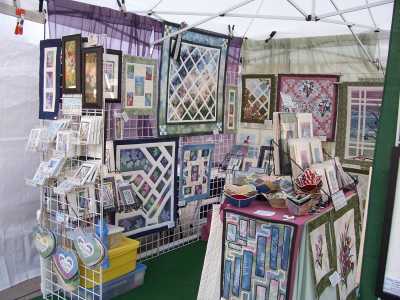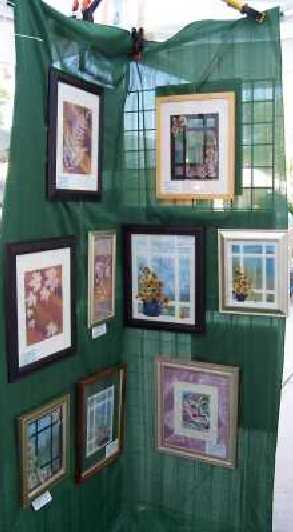Outdoor Tent Display
This page is for those who may be interested in how I set up my tent display for outdoor art shows. I am not great describing things with words, but hope these can be of some help. I have been modifying things as I have gone along. 2007 is the 15th year I have been selling at shows. I learn more each time I do another.

Front view of tent display on grass. I have 10 panels 2'x6' of white gridwall that I use for display. I have an assortment of hooks that work with the gridwall, small drapery hooks, and s-hooks for hanging framed pieces. In this display, I used 5 panels in the back- I had extra space to the right of the tent for demonstrations, so I could use the full 10' in back for display, keeping my cash register table, and demo table outside the tent, under an awning. A 6th panel is attatched on the left at right angle, on its side (attatched to the top of the back wall panel, and the pair of front panels set at a right angle), to give more hanging space, and for stability. I use cable ties to connect the panels to each other, and also attatch the panels to the tent frame at the top, and at corners where possible. This adds stability to the wall, and adds weight to hold down the tent. The left wall is 8' wide, with 6' of it only 2' high from the top. I hang sheer curtains behind the wall panels to dress things up, and on hot days, when I take down the tarp walls, air can circulate to keep it from getting so hot, while blocking distractions from outside. Right front is 2 panels at right angles to display things on inside and out. I hung a white lace curtain on this, so I could use drapery hooks through the lace for hanging framed pieces on the inside. My beaded pins are displayed on pieces of foamcore covered with fabric, to pin the cards they are mounted on, to them. One is on front panel, and one is inside above rack of small pieces. The awning is formed by 2- 5'long firring strips, each with a hole in one end for a 10' pipe, and a notch in the other end, where it rests on the tent frame, and is clamped to the frame (bottom right picture shows the clamped end in the upper left of the pic.- orange clamps). the tarp sidewall is put over the pipe, and clamped to hold it in place. I use outdoor grass carpet on the "floor".

This is an inside view of the above display. You can barely see the left panel behind the small pieces in the top corner. In an ideal world, I would have 2 more panels, so I could have grid all the way to the ground, but I make do with what I have for now. The Iris piece on the left wall is hung from the bottom edge of the gridwall, hiding the fact that there is no grid behind it. The black metal rack in the corner, is a magazine or literature display rack that I bought. It is 2'wide, and can bu used on a counter, or as here, hung with 2 large s-hooks. I use these to display my smaller pieces for framing. They are packaged in clear bags (clearbags.com) with backer boards to give them stability. This works very well for me- the pieces stay clean and dry and customers can leaf through them and see them easily. Also in this picture, you can see at the top, how I make use of all the height I can, by clamping a firring strip (cheap 1x3 lumber) to the top of the tent frame. The curtains are threaded onto the boards by their hems, which are big enough for the firring strips to go through. I use 2 sheer panels 84" long by nearly 60", just fits the 10' span. The cable ties attatching the walls to the frame are placed in the corners, and centers of the walls, so they don't interfere with the curtains. I use L-hooks screwed into the boards, right through the curtains to hang the quilts high up. The rods rest on the hooks. Under the rack of small pieces, is one of my totes covered with a cloth, that I use to pile older pieces, or things I don't have room to hang- people love to "paw" through these. In the right corner, you can see my cash register, I got lazy many years ago, and got this to help make sales go faster. It is electric, and I carry a marine battery and inverter for electric, when it is not available. The above display pictures are from the last outdoor show of the season. The pictures below, are from much earlier in the season, and I think the display looks much more jumbled then, but the pics show a little better how the curtains are hung, etc.


Here are a couple more views from another show. In this setup, I used 5 panels on the left wall, one at right angles on the front. I use the front facing panel to display my notecards, and smaller pieces to grab attention. I only used 3 panels in the back, because traffic flowed on 3 sides of this display. At this show, I used a larger table in the center of the tent, for a rack of small quilts, and fabric bowls, I hang quilts on the skirt of the table, to make use of any display surface I can. In later shows (the first pictures), I have been using wooden tray tables for display. I also usually have my totes covered up- I think in this picture, the yellow tote, and others with it were there, uncovered, due to a thunderstorm that morning-totally unexpected. This show was on a sidewalk area, so anything touching the ground got wet, and needed hanging to dry. Each show is a new experience, and setups end up changing to meet the differences. The picture below shows how I used a table cloth as a backdrop over the gridwall for displaying framed pieces. I now use a lace curtain most of the time- I used the dark clothe here, because I needed some shade from tne sun that came in from that side. The weave of the table cloth is quite open, so I could use drapery hooks right through it to hang the frames from. You can see that there are other things displayed on the other side. I also now use small binder clips instead of the ugly clamps to hold up the cloths or curtains- they look much better. I keep learning more each show I do, and make changes. This was on concrete, so I could not stake corners down, but the sidewalls connected to the tent frame are quite heavy, and I also have 2'sections of 4" drain pipe filled with concrete, with large eye bolts in the top of the conrete, that I hang from the top of the corners of thent using bungee cords. Hulahoops also help a lot stuck between the tent top and the upper frame, to keep the top from collecting water during rain storms. I did'nt think I needed them for this show, but an unexpected thunderstorm popped up early morning, and I spent an hour or more pushing water out of the top with a board. I don't leave the hoops home, now.



















